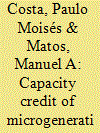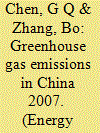|
|
|
Sort Order |
|
|
|
Items / Page
|
|
|
|
|
|
|
| Srl | Item |
| 1 |
ID:
098695


|
|
|
|
|
| Publication |
2010.
|
| Summary/Abstract |
The effect on the cost of electricity from concentrating solar power (CSP) plants of the solar multiple, the capacity factor and the storage capacity is studied. The interplay among these factors can be used to search for a minimal-cost objective that can serve as a technical criterion to guide in the design of economic incentives for CSP plants. The probability-density function of irradiation is used in conjunction with screening models to evaluate the performance characteristics and costs of concentrating solar power plants. Two technologies have been analyzed in this study: parabolic-trough and tower plants. The results provide information to define the optimal operational range as a function of the desired objective. Thus, it is possible to derive a technical criterion for the design of CSP plants which optimizes the solar electricity produced and its generation cost. The methodology is applied to Spain, and the analysis of the results shows that a solar energy production of 37 kWh/m2/year for tower plants and 66 kWh/m2/year for parabolic-trough ones define the approximate optimal working conditions for the mean DNI in Spain.
|
|
|
|
|
|
|
|
|
|
|
|
|
|
|
|
| 2 |
ID:
098693


|
|
|
|
|
| Publication |
2010.
|
| Summary/Abstract |
In this study, efficiency analyses of the eleven lignite-fired, one hard coal-fired and three natural gas-fired state-owned thermal power plants used for electricity generation were conducted through data envelopment analysis (DEA). Two efficiency indexes, operational and environmental performance, were defined and pursued. In the calculation of the operational performance, main production indicators were used as input, and fuel cost per actual production (Y) was used as output (Model 1). On the other hand, in the calculation of the environmental performance, gases emitted to the environment were used as output (Model 2). Data envelopment analysis (DEA) is the main instrument for the measurement of relative performances of the decision making units with multiple inputs and outputs. Constant returns to scale (CRS or CCR) and variable returns to scale (VRS or BCC) type DEA models were used in the analyses. The relationship between efficiency scores and input/output factors was investigated. Employing the obtained results, the power plants were evaluated with respect to both the cost of electricity generation and the environmental effects.
|
|
|
|
|
|
|
|
|
|
|
|
|
|
|
|
| 3 |
ID:
098688


|
|
|
|
|
| Publication |
2010.
|
| Summary/Abstract |
Nuclear energy, which was once considered as the fuel of future and was abandoned after Chernobyl accident, has emerged recently in developed and developing countries as an option to combat climate change, to secure supply and to achieve sustainable development. Turkey, a developing country where most of the electricity is produced from fossil fuels and which has energy security problems, has adopted a new legislation giving financial incentives for nuclear power plant construction, along with a tender in 2008. However, the tender ended in a stalemate after the Council of State's decision in November 2009. An evaluation of Turkey's nuclear policy in light of South Korea's nuclear experience gives us an explanation as to why Turkey failed in the last tender. Basically it was due to lack of a long term nuclear energy policy that comprehends social, economical, technical and political aspects of nuclear energy. Thus, it is argued that Turkey can benefit from nuclear energy if it formulates a comprehensive nuclear energy plan clearly interwoven with its economic development plans, establishes a proper legal framework and has domestic industry participation in nuclear technology development.
|
|
|
|
|
|
|
|
|
|
|
|
|
|
|
|
| 4 |
ID:
098690


|
|
|
|
|
| Publication |
2010.
|
| Summary/Abstract |
Finnish farmers' role as energy producers is small compared to their role as energy resource owners. Since climate and energy policy in Finland continues favoring large-scale energy visions, additional investment support for agriculture will stay modest. To utilize fully the energy potential in farms, we analyze the farmers' decision-making environment. First, we present an overview of the Finnish energy policy and economy and their effect on farms (the top-down perspective). Then we analyze the drivers behind the bioenergy decisions of farms in general and in the Oulu region, located in Northern Finland (the bottom-up perspective). There is weak policy coherence between national and regional energy efforts. Strong pressure is placed on farmers to improve their business and marketing knowledge, innovation and financial abilities, education level, and networking skills. In the Oulu region, bioenergy forerunners can be divided in three different groups - investors, entrepreneurs and hobbyists - that have different levels of commitment to their energy businesses. This further stresses the importance of getting quality business services from numerous service providers.
|
|
|
|
|
|
|
|
|
|
|
|
|
|
|
|
| 5 |
ID:
098683


|
|
|
|
|
| Publication |
2010.
|
| Summary/Abstract |
This paper is based on an elaborate research project carried out in 2008. International 'Peak Oil' predictions were translated to the South African context as a basis for the energy analysis. Based on available plans for the implementation of new power plants, and the like, various energy availability scenarios were developed. On the transportation side, the current transport demand (passenger and freight) was combined with fuel efficiency knowledge in the transportation field. Planned or proven international efficiency improvement interventions were assessed regarding their feasibility in the South African context. Furthermore, implementation trajectories up to the year 2030 were developed for all potential efficiency measures. Finally, the energy availability scenarios and feasible energy measure trajectories were combined to provide the client with investment suggestions and other conclusions and recommendations.
|
|
|
|
|
|
|
|
|
|
|
|
|
|
|
|
| 6 |
ID:
098706


|
|
|
|
|
| Publication |
2010.
|
| Summary/Abstract |
The recent development of the concept of microgrid (?Grid), associated to the emergent interest in microgeneration (?Gen), has raised a number of challenges regarding the evaluation of the technical, economical and regulatory impacts of a high penetration of this kind of solutions in the power systems. In this paper, the topic of security of supply is addressed, aiming at evaluating the influence of ?Gen and ?Grids in the medium- and long-term availability of generation to serve the forecasted load. A Monte-Carlo based methodology is used to evaluate this influence and to assess the capacity credit of those entities.
|
|
|
|
|
|
|
|
|
|
|
|
|
|
|
|
| 7 |
ID:
098691


|
|
|
|
|
| Publication |
2010.
|
| Summary/Abstract |
Data envelopment analysis (DEA) has recently become a popular method in measuring energy efficiency at the macro-economy level. However, previous studies are limited in that they failed to consider the issues of undesirable outputs and minimisation of energy consumption. Thus, this study considers both factors in measuring Chinese industrial energy efficiency and investigates the maximum energy-saving potential in 28 administrative regions in China. The results show that industries in the east area have the best average energy efficiency for the period 2000-2006, followed by the central area. Further, after comparing the industrial energy overall efficiency, pure technical efficiency (IEPTE), and scale efficiency of the 28 administrative regions examined, the study finds that in most regions of this study, the two main reasons causing the wastage of a large amount of energy during the industrial production process are that the industrial structure of most regions still relies on the massive use of energy in order to support the industrial-based economy and the IEPTE is too low. Based on these findings, this paper correspondingly proposes some policies to improve regional industrial energy efficiency.
|
|
|
|
|
|
|
|
|
|
|
|
|
|
|
|
| 8 |
ID:
098689


|
|
|
|
|
| Publication |
2010.
|
| Summary/Abstract |
Greater use of renewable energy is being aggressively promoted to combat climate change by the Chinese government and by other governments. Agricultural straw is the kind of renewable energy source that would become a pollution source if it is not well utilized. We select the Shiliquan straw-based electricity generation project in Shandong Province, China as a case and assess environmental externalities of straw utilization in power plants by using life-cycle analysis. Results show that straw-based electricity generation has far fewer greenhouse gas (GHG) emissions than that of coal-based electricity generation. Improvement in the energy efficiency of equipment used for straw's pretreatment would lead to a decrease of GHG emissions and energy consumption in the life-cycle of straw-based electricity generation. In case 400 million tonnes of wasted straw in China could be used as a substitute for 200 million tonnes of coal, annually the straw 291 Terrawatt hours (TWh) of electricity could be generated, resulting in an annual total CO2 emissions savings of 193 million tonnes. Straw-based electricity generation could be a high-potential alternative for electricity generation as well as an incentive for utilizing wheat straw instead of burning it in the field.
|
|
|
|
|
|
|
|
|
|
|
|
|
|
|
|
| 9 |
ID:
098681


|
|
|
|
|
| Publication |
2010.
|
| Summary/Abstract |
Energy use in the production of desirable output often results in the generation of undesirable emission with detrimental impact on the environment, and whose disposal is frequently monitored by public authorities. Previous studies, however, paid little attention to undesirable output and environmental regulation related to its disposal while estimating energy use efficiency. Analysis of energy efficiency ignoring undesirable output could result in biased estimates of efficiency. Thus the aim of this paper is to estimate energy use efficiency in the presence of energy related undesirable emission by taking Indian cement industry as a suitable context of my analysis. Depending on the presence and absence of undesirable output and environmental regulation, three measures of efficiency have been estimated at the state level from 2000-01 to 2004-05 by applying Data Envelopment Analysis. Energy efficiency is defined as the ability of the producer to reduce the energy input to the largest extent possible, conditional on the given level of output and non-energy inputs. Empirical results reveal that energy efficiency estimates are biased if only desirable output is considered. Results also demonstrate that environmental regulation has a reinforcing effect on energy use efficiency.
|
|
|
|
|
|
|
|
|
|
|
|
|
|
|
|
| 10 |
ID:
098702


|
|
|
|
|
| Publication |
2010.
|
| Summary/Abstract |
Stabilising the concentration of CO2 in the atmosphere at a level of 450 ppm in order to keep global temperature increase below 2 °C requires an ambitious climate policy. This study analyses the role of different technologies in the EU-27 with regard to efficiency improvements, fuel switching and energy saving measures under such a climate policy target. The analysis is carried out using the regionalised Pan-European TIMES energy system model, a technology oriented, linear optimisation model. Thereby limited resources and import potentials of various energy carriers, competition among different sectors and the country-specific differences in energy demand are taken into account. As a result, it turns out that the structure of energy use inside the EU-27 is much stronger, influenced by political targets and positions regarding climate protection, energy security and the use of nuclear energy than by available technologies. In the case of climate protection polices and limited use of nuclear energy, the most important measures for the reduction of greenhouse gases are an increased use of renewables, carbon capture and storage, fuel switching and the intensified application of electricity in the end use sectors. Efficiency improvements play an additional role when security of supply is taken into account.
|
|
|
|
|
|
|
|
|
|
|
|
|
|
|
|
| 11 |
ID:
098686


|
|
|
|
|
| Publication |
2010.
|
| Summary/Abstract |
Achieving a 'step-change' in energy efficiency behaviours will require enhanced knowledge of behavioural drivers, and translation of this knowledge into successful intervention programmes. The 'Energy Cultures' conceptual framework aims to assist in understanding the factors that influence energy consumption behaviour, and to help identify opportunities for behaviour change. Building on a history of attempts to offer multi-disciplinary integrating models of energy behaviour, we take a culture-based approach to behaviour, while drawing also from lifestyles and systems thinking. The framework provides a structure for addressing the problem of multiple interpretations of 'behaviour' by suggesting that it is influenced by the interactions between cognitive norms, energy practices and material culture.
The Energy Cultures framework is discussed in the context of a New Zealand case study, which demonstrates its development and application. It has already provided a basis for cross-disciplinary collaboration, and for multi-disciplinary research design, and has provided insights into behavioural change in a case study community. As the conceptual basis of a 3-year research project, the framework has further potential to identify clusters of 'energy cultures' - similar patterns of norms, practices and/or material culture - to enable the crafting of targeted actions to achieve behaviour change.
|
|
|
|
|
|
|
|
|
|
|
|
|
|
|
|
| 12 |
ID:
098694


|
|
|
|
|
| Publication |
2010.
|
| Summary/Abstract |
The main purpose of this paper is to emphasize the importance of including environmental degradation costs in the long-term planning of the Brazilian electricity sector. To this aim, environmental external costs associated to both hydro-power and thermal-power electricity generation are investigated. Monetary valuation methodologies are applied and environmental degradation costs, expressed in per kWh of generated energy, are obtained for the main types of generation sources of the Brazilian electricity matrix. Both local pollution due to particulate matter emissions and global warming effects are assessed. A classification of the sources from the point of view of their impact on the environment is given. Degradation costs associated to the installed capacity expansion in the Brazilian electricity sector during the time horizon 2007-2016 are estimated. These resulting costs represent lower boundary damage estimates associated only with the energy to be generated during the period. Results indicate that local pollution caused by a small number of plants could be even more costly to society than global warming and, also, show the importance of considering not only unitary damage costs but the participation of each source on the generated energy during the time horizon, as a guide to planning and policy making.
|
|
|
|
|
|
|
|
|
|
|
|
|
|
|
|
| 13 |
ID:
098708


|
|
|
|
|
| Publication |
2010.
|
| Summary/Abstract |
In order to step up its efforts in reducing climate change, the European Commission (hereafter: the Commission) has launched in June 2000 its European climate change program (hereafter: ECCP). This wide-ranging stakeholder consultation aimed at identifying and developing all elements necessary for a European climate change strategy. The ECCP formally came to a close in April 2003.
This paper analyses the inner workings of ECCP, and how ECCP has delivered with regard to its objectives. Special attention is paid to ECCP's Working Group 1, "Flexible Mechanisms", which developed the foundations for the European emission trading scheme (hereafter: EU ETS). The paper draws on documents published on the Commission's ECCP web-site, on academic literature, on press releases from stakeholders and on interviews with four participants in the ECCP process. Using this method, the paper offers important insights as to how the consensus-building for establishing the world's biggest carbon-trading scheme has started long time before the formal legislative process.
|
|
|
|
|
|
|
|
|
|
|
|
|
|
|
|
| 14 |
ID:
098698


|
|
|
|
|
| Publication |
2010.
|
| Summary/Abstract |
The current subsidized energy prices in Iran are proposed to be gradually eliminated over the next few years. The objective of this study is to examine the effects of current and future energy price policies on optimal configuration of combined heat and power (CHP) and combined cooling, heating, and power (CCHP) systems in Iran, under the conditions of selling and not-selling electricity to utility. The particle swarm optimization algorithm is used for minimizing the cost function for owning and operating various CHP and CCHP systems in an industrial dairy unit. The results show that with the estimated future unsubsidized utility prices, CHP and CCHP systems operating with reciprocating engine prime mover have total costs of 5.6 and $2.9×106 over useful life of 20 years, respectively, while both systems have the same capital recovery periods of 1.3 years. However, for the same prime mover and with current subsidized prices, CHP and CCHP systems require 4.9 and 5.2 years for capital recovery, respectively. It is concluded that the current energy price policies hinder the promotion of installing CHP and CCHP systems and, the policy of selling electricity to utility as well as eliminating subsidies are prerequisites to successful widespread utilization of such systems.
|
|
|
|
|
|
|
|
|
|
|
|
|
|
|
|
| 15 |
ID:
098692


|
|
|
|
|
| Publication |
2010.
|
| Summary/Abstract |
For greenhouse gas (GHG) emissions by the Chinese economy in 2007 with the most recent statistics availability, a concrete inventory covering CO2, CH4, and N2O is composed and associated with an input-output analysis to reveal the emission embodiment in final consumption and international trade. The estimated total direct GHG emission amounts to 7456.12 Mt CO2-eq by the commonly referred IPCC global warming potentials, with 63.39% from energy-related CO2, 22.31% from non-energy-related CO2, 11.15% from CH4 and 3.15% from N2O. Responsible for 81.32% of the total GHG emissions are the five sectors of the Electric Power/Steam and Hot Water Production and Supply, Smelting and Pressing of Ferrous and Nonferrous Metals, Nonmetal Mineral Products, Agriculture, and Coal Mining and Dressing, with distinctive emission structures. The sector of Construction holds the top GHG emissions embodied in both domestic production and consumption, and the emission embodied in gross capital formation is prominently more than those in other components of the final consumption characterized by extensive investment in contrast to limited household consumption. China is a net exporter of embodied GHG emissions, with emissions embodied in exports of 3060.18 Mt CO2-eq, in magnitude up to 41.04% of the total direct emission.
|
|
|
|
|
|
|
|
|
|
|
|
|
|
|
|
| 16 |
ID:
098703


|
|
|
|
|
| Publication |
2010.
|
| Summary/Abstract |
China's 11th Five-Year Guideline identified energy conservation as one of the country's fundamental policies and established a mandatory target: 20% reduction in national average energy intensity by 2010. Despite the various policies, laws, and administrative reforms to support energy conservation, China fell behind schedule for meeting its conservation targets in 2006 and 2007. Using a combination of available literature and an interview-based case study, this paper examines the implementation of energy conservation and investigates impediments to achieving China's conservation goal in the electric power generation sector. Three key impediments are detailed: (1) municipal governments' incentives to overlook conservation-related central directives primarily because of budget pressures linked to financial decentralization, (2) procedural obstacles in the form of time required to obtain project approvals for high-efficiency power generation units, and (3) financial obstacles making it difficult for power generation enterprises to raise capital for energy conservation projects. An interview-based case study of a state-owned coal-fired electric power generation company demonstrates the influence of the aforementioned obstacles. While procedural obstacles are notable, they can be managed. However, electricity pricing reforms and/or stronger subsidy programs will be needed to address the financial obstacles facing Chinese power generation companies.
|
|
|
|
|
|
|
|
|
|
|
|
|
|
|
|
| 17 |
ID:
098687


|
|
|
|
|
| Publication |
2010.
|
| Summary/Abstract |
Building mounted micro-wind turbines and photovoltaics have the potential to provide widely applicable carbon free electricity generation at the building level. Photovoltaic systems are well understood and it is easy to predict performance using software tools or widely accepted yield estimates. Micro-wind, however, is far more complex and in comparison poorly understood. This paper presents the key findings of the building mounted (<2 kWp) turbine component of the UK micro-wind trial undertaken by the Energy Saving Trust in 2008/09. The monitored performance of 39 horizontal axis turbines in urban, suburban and rural locations is discussed alongside the accuracy of predictive wind speed tools for the sites. The performance of urban and suburban micro-wind sites in the trial was poor with annual generation of less than 75 kWh/m2 swept area, the majority of which were less than 25 kWh/m2. Good rural sites had an annual generation of between 100 and 280 kWh/m2, far less than the nominal 360 kWh/m2 (10% load factor for a typical turbine) that is often assumed. In the light of these findings, the potential impact of the UK's latest policy instrument, the 2010 micro-generation tariffs, is considered for both micro-wind and photovoltaics.
|
|
|
|
|
|
|
|
|
|
|
|
|
|
|
|
| 18 |
ID:
098704


|
|
|
|
|
| Publication |
2010.
|
| Summary/Abstract |
In this paper, an innovative model of agent based simulation, based on Ant Colony Optimization (ACO) algorithm is proposed in order to compare three available strategies of clearing wholesale electricity markets, i.e. uniform, pay-as-bid, and generalized Vickrey rules. The supply side actors of the power market are modeled as adaptive agents who learn how to bid strategically to optimize their profit through indirect interaction with other actors of the market. The proposed model is proper for bidding functions with high number of dimensions and enables modelers to avoid curse of dimensionality as dimension grows. Test systems are then used to study the behavior of each pricing rule under different degrees of competition and heterogeneity. Finally, the pricing rules are comprehensively compared using different economic criteria such as average cleared price, efficiency of allocation, and price volatility. Also, principle component analysis (PCA) is used to rank and select the best price rule. To the knowledge of the authors, this is the first study that uses ACO for assessing strategies of wholesale electricity market.
|
|
|
|
|
|
|
|
|
|
|
|
|
|
|
|
| 19 |
ID:
098705


|
|
|
|
|
| Publication |
2010.
|
| Summary/Abstract |
Many factors contribute to the planning process of power systems. In the context of expansion planning, focus is paid to selection criteria that enable the optimization of related factors that will result in the best performance. This is described as meeting demand whilst reducing costs and maintaining minimal risk in operation. In this paper, different criteria used in the planning of power system expansion studies are investigated with the objective of identifying their impact on the expansion plan. The results of these criteria on the expansion study of the Jordanian power system are presented. Results show good correspondence to the actual adopted solutions. The spinning reserve is the most influential planning criterion on the overall system expansion cost. This is followed by the peak load changes, and the forced outage rate of the candidate units used for capacity additions to meet future expected demand. Finally, the loss of load expectation and cost of energy not served have the least effect on the overall system expansion cost. These results highlight the importance to be placed on performing sensitivity analyses to determine the most cost effective and acceptable expansion plan of the electric power system. There is a need to continually update the planning criteria to cater for changes and developments in the power system and the economic situation. Finally, the methodology of this study can be generalized to other power systems.
|
|
|
|
|
|
|
|
|
|
|
|
|
|
|
|
| 20 |
ID:
098685


|
|
|
|
|
| Publication |
2010.
|
| Summary/Abstract |
This paper explores how UK householders interacted with feedback on their domestic energy consumption in a field trial of real-time displays or smart energy monitors. After examining relevant bodies of literature on the effects of energy feedback on consumption behaviour, and on the complex role of energy and appliances within household moral economies, the paper draws on qualitative evidence from interviews with 15 UK householders trialling smart energy monitors of differing levels of sophistication. It focuses specifically on householder motivations for acquiring the monitors, how the monitors have been used, how feedback has changed consumption behaviour, and the limitations to further behavioural change the householders experienced. The paper concludes by identifying significant implications for future research and policy in this area.
|
|
|
|
|
|
|
|
|
|
|
|
|
|
|
|
|
|
|
|
|